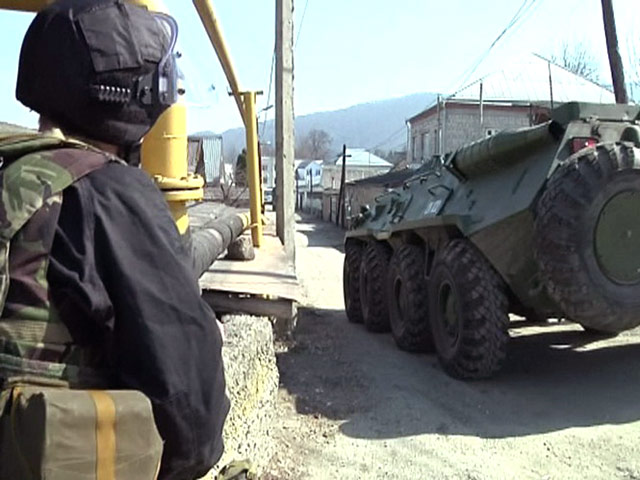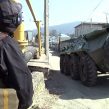
Clashes Between Police and Militants Continue to Be Reported in Kabardino-Balkaria
Publication: Eurasia Daily Monitor Volume: 10 Issue: 138
By:

On July 17, the Kabardino-Balkarian interior minister summed up the results of the first six months of the year during a press conference in the republican capital, Nalchik. The minister was forced to admit that the government had failed to achieve decisive results in the fight against extremism and terrorism in the republic. The official highlighted the scope of extremism’s spread in Kabardino-Balkaria, citing the example of a high school student who had helped the insurgents (www.regnum.ru/news/1685071.html#ixzz2Zx99gF82). This is part of a general trend of members of the insurgency in Kabardino-Balkaria and in the North Caucasus as a whole becoming younger.
News reports of armed incidents and the discovery of temporary rebel bases across the republic show Kabardino-Balkaria is far from quiet (www.contrasterra.ru/news/11467). Still, the frequency with which the police claim to have found rebel weapons caches is suspicious and might be an indicator of the eagerness of the local police to show results by “cooking up” the necessary evidence in order to show Moscow they are being vigilant in the battle against extremism.
On July 5, a man who allegedly attacked police was killed in a firefight in Nalchik. According to the Kabardino-Balkarian police, the incident took place at the intersection of the Shogenov Street and Kalmykov Street at around four in the afternoon. “As the police attempted to check his documents, the armed criminal, whose identity is still being established, fired shots at the police using an automatic weapon and was neutralized by response actions,” the website of the republican police said (www.kavkaz-uzel.ru/articles/226676/). The incident looks more like the police attempted to arrest someone they were following rather than an accidental encounter between police officers and a random resident of Nalchik.
On July 9, a militant was killed in a wooded area near the village of Dugulubgei in Kabardino-Balkaria’s Baksan district. The republican branch of the Investigative Committee asserted that the slain militant had resisted police (www.gazeta.ru/social/news/2013/07/09/n_3029217.shtml). It also appears that someone had reported the militant to the police, rather than the police accidentally encountering a random rebel.
On July 12, security forces blockaded three suspected members of the illegal armed groups in a house in an area of elite dachas in Truzhenik, which is located on the outskirts of Nalchik. All three suspects were killed (www.newsru.com/russia/12jul2013/nalchik.html). The government forces included servicemen for various agencies who used armored personnel carriers. This suggests the special operation was carefully prepared in advance.
On the evening of July 13, unidentified assailants fired on a police patrol in Nalchik. The attack took place in the vicinity of school #14 on Kuliev Boulevard. “Three police officers received injuries and one of them later died,” Kabardino-Balkarian Interior Ministry spokesperson Marina Kyasova said (www.region-07.ru/e/3086800-bandityi-obstrelyali-naryad-pps-v-nalchike).
On July 15, two suspected militants attacked police officers in Kabardino-Balkaria’s Tersky district. One of the attackers was killed, but the second managed to run away. The police officers were unharmed (www.kavkaz-uzel.ru/articles/227103/).
On July 18, government forces clashed with a group of insurgents in the Baksan district village of Islamei. The insurgents call this area the Northeastern Sector of the Velayat KBK. The four slain suspected rebels were subsequently identified as 30-year-old Dmitry Mironov and 31-year-old Ruslan Imamov along with his two 35-year-old brothers Aslan Imamov and Nazhmudin Kunizhev (www.ntv.ru/novosti/632217/). “The slain people were members of a cell in a banned terrorist organization and took part in a range of murders and attempted murders, including an attack on a police patrol on July 13, in which two police officers were killed,” a National Antiterrorist Committee (NAC) official reported. “Apart from that, the bandits planned to carry out several large-scale terrorist attacks in the immediate future” (www.regnum.ru/news/kavkaz/kab-balk/1685385.html#ixzz2Zx7tA0o3). As ever, the NAC failed to specify how they found out about the future plans of the slain insurgents.
On July 23, the driver of a Mercedes-Benz failed to obey the police’s signals to stop on the Chegem-Yanikoi highway in Kabardino-Balkaria’s Chegem district, instead ramming the police car. After the collision, the driver fired shots at the police and was killed by return fire. According to the interior ministry, the slain driver was identified as Alim Kozdeyev, a 25-year-old resident of Baksan and a member of an illegal armed group (www.interfax.ru/russia/news.asp?id=319935).
Evidently, Kabardino-Balkaria is currently not experiencing the same level of tensions as it did in 2009–2010, but frequent clashes between the police and the rebels prevent the police from disregarding the security threats. Despite the fact that more militants die in the clashes than government servicemen, the ranks of the insurgents do not appear to be shrinking. Thus, Kabardino-Balkarian Interior Minister Sergei Vasiliev is probably right when he says the rebels’ ranks are primarily replenished with young people, who regard the militants as the people fighting the arbitrariness of the authorities and Russian policies in Kabardino-Balkaria. This fresh influx of young recruits often complicates police efforts to identify slain rebels because they are not in police databases (https://www.kavkaz-uzel.ru/articles/226683/).
Another interesting development is that Russian surnames repeatedly appear among the names of insurgents killed in Kabardino-Balkaria. These are normally ethnic Russians who converted to Islam and took up arms against the authorities. For example, Dmitry Mironov was killed on July 18 in the village of Islamei, 19-year-old Alexander Popov was killed on July 12, and 20-year-old Eduard Khodorkovsky from the city of Nartkala was arrested on June 29. Hence it is evident that the militants are becoming increasingly multiethnic. The involvement of ethnic Russians in the Caucasus Emirate is no longer rare. This further complicates the government’s fight against the insurgency, and makes it unlikely that the security situation in Kabardino-Balkaria will change for the better anytime soon. It also creates a security dilemma for Moscow with the Sochi Olympics around the corner because the existence of ethnic Russian converts fighting with the militants is a tool that can easily be used by the Caucasus Emirate to infiltrate the Winter Olympic Games should Doku Umarov fulfill his recent pledge to attack next year’s sporting event.




